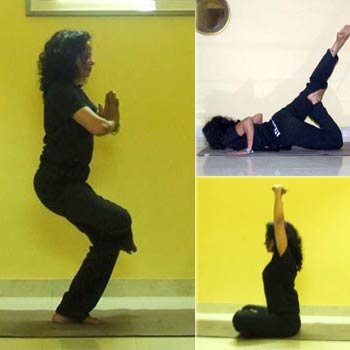
As it is with other exercise routines, it is possible to focus on one aspect of training at the expense of other parts of the body even in yoga. An ideal practice should combine practices that work out the entire body. One's upper body, lower back and overall stamina must be challenged independently, in one session, to reach complete fitness.
In fact, working one part of the body exclusively will compromise the flexibility and agility of the others. This explains why joggers can have strong yet stiff legs. Similarly, dancers can have great stamina but weak knees or necks.
In yoga, flexibility is emphasised since it implies the smooth lubrication of joints, optimal flow of blood, oxygen, nutrients and repairing agents. Flexibility is equated with youth and complete health in yoga.
Here, Shameem Akthar, yoga acharya trained with the international Sivananda Vedanta Yoga Center, takes you through five poses that guarantee flexibility.
Catch more of Shameem's yoga writings and information about her upcoming workshops at jaisivananda.blogspot.com.
This article only attempts to enthuse readers towards yoga practice and complement one's existing practice. Yoga is best learnt under the personal guidance of a teacher.
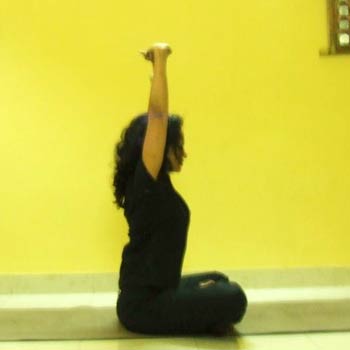
Sit cross-legged (this may also be done seated in a chair). Inhale, raising your arms overhead. Interlock your fingers, turning them outward towards the ceiling. Exhale. Inhaling, stretch completely as much as you can, as if someone were pulling you up by your hands. Hold the stretch.
If you do not have high blood pressure, heart or respiratory problems, you may hold your breath while stretching completely.
Release the pose, inhale. Repeat three to five times.
Benefits: Stretches the upper body thoroughly. Boosts respiration. Peps up the mind. Relieves repetitive injury syndrome.
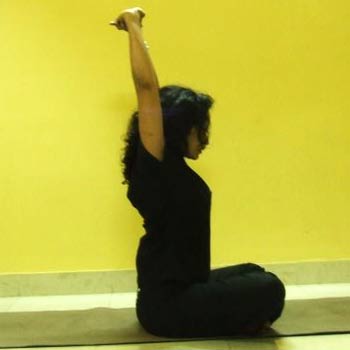
Sit cross-legged (may also be done seated in a chair). Interlock your fingers. Inhaling, raise your hands overhead. Turn your palms outwards, towards ceiling. Stretch.
Exhaling, pull your arms backwards lightly, feeling an intense stretch across your shoulders. Hold the pose, breathing normally throughout. Release. Repeat three to five times.
Benefits: Stretches the upper body, relieves frozen shoulders. Prevents job-related repetitive injury syndrome. Stimulates the mind.
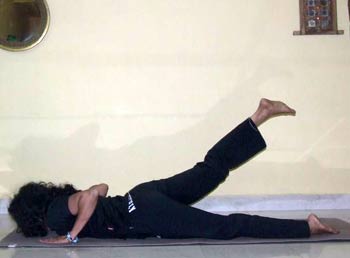
Lie on your stomach, palms flat under your shoulders as shown. Your chin should rest on the ground. Inhale and raise your right leg as high as you can. Exhale and drop it back to ground. Do this five to ten times. Repeat for the left leg.
Benefits: Stretches the hip joints, tones the back of the legs, works all the major leg muscles. Boosts respiration. Releases fat, due to pressure on liver. Challenges the heart, toning it. Prevents middle and lower back problems.
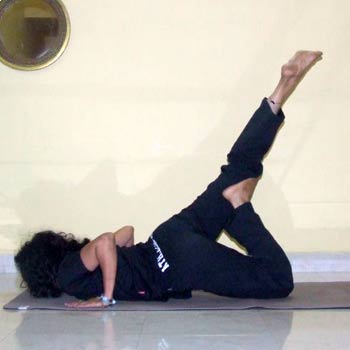
Lie on your stomach, palms flat under your shoulders as shown. Your chin should rest on the ground. Inhale and raise your right leg as high as you can. Hoist your left leg, as shown, to place it under the right thigh comfortably. Continue normal breathing, holding the pose as long as you can.
Release, dropping your right leg back to ground with an exhalation. Do thrice. Then repeat entire sequence for the other leg.
Benefits: Same as the previous pose, only more enhanced.
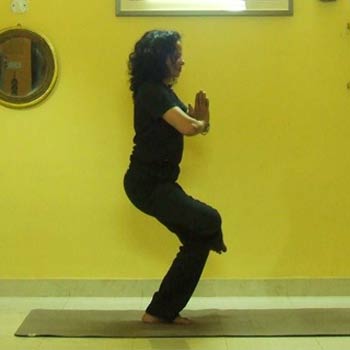
Stand on one leg (you must already have practiced the basic one-legged pose to be able to execute this version). Start by standing on your right leg, folding your left leg at the knee and placing it on the right thigh as shown. Then place your palms at your chest (or overhead) together in the namaste gesture. Breathe normally throughout. Then inhale. Exhaling, lower your hips lightly, to squat on one leg. Hold for as long as possible. Release, to repeat for the other side.
Benefits: Improves focus. Improves leg and hip flexibility.